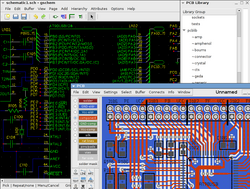History
The gEDA project was started by Ales Hvezda in an effort to remedy the lack of free software EDA tools for Linux/UNIX. [4] The first software was released on 1 April 1998, and included a schematic capture program and a netlister. [5] At that time, the gEDA Project website and mailing lists were also set up.
Originally, the project planned to also write a PCB layout program. However, an existing open-source layout program, "PCB", was soon discovered by the project. Thereafter, the ability to target netlists to PCB was quickly built into the gEDA Project's netlister, and plans to write a new layout program from scratch were scrapped. Meanwhile, developers working on PCB became affiliates of the gEDA Project.
Other open-source EDA programs were created at about the same time. The authors of those programs became affiliated with the gEDA website and mailing lists, and the collaborative gEDA Project was born.
At present, the gEDA Project remains a federation of software tools developed by different (but sometimes overlapping) programmers. The thread which holds the project together is the shared vision of creating a powerful, community-based, open-source EDA toolkit.
pcb-rnd was forked from gEDA/PCB in 2013.
Lepton EDA was forked from the gEDA/gaf suite in late 2016.
Linux
Because one of the gEDA Project's longstanding goals is to provide a suite of EDA applications for Linux, all applications in the gEDA Suite compile and run on Linux. Besides building the programs from source, binary executables for all programs in the gEDA Suite are available from popular package archives; the programs may be installed on many common Linux distributions using package management tools such as apt or dnf.
Unix
All gEDA applications will also compile and run on other Unix-like operating systems, such as OpenBSD, FreeBSD and NetBSD. Some of these distributions also support installation of pre-packaged binaries using package management utilities.
Mac OS X
Most gEDA applications also install and run successfully on Mac OS X, typically using the Fink package manager and Macports. Since few commercial EDA tools run on the Mac, this feature has made gEDA a popular electronic design package amongst Mac users.
Microsoft Windows
Microsoft Windows support is currently not a primary project goal. Nonetheless, some programs in the gEDA Suite have built-in hooks for Windows support, and those programs will build and run under Windows. However, binary executables for most of the gEDA Suite are not distributed by the gEDA Project.
An important feature of the gEDA project is the strong user community it has created. [6] The gEDA mailing lists have several hundred subscribers, and many subscribers are electronics experts. Thus, the gEDA mailing lists have become a source not only for information related to the gEDA applications, but also for exchange of general electronic design information.
As a consequence of the project's openness, schematic symbols, footprints, and utility scripts are freely created and shared amongst the members of the gEDA community at a spin-off website, www.gedasymbols.org.
This page is based on this
Wikipedia article Text is available under the
CC BY-SA 4.0 license; additional terms may apply.
Images, videos and audio are available under their respective licenses.


